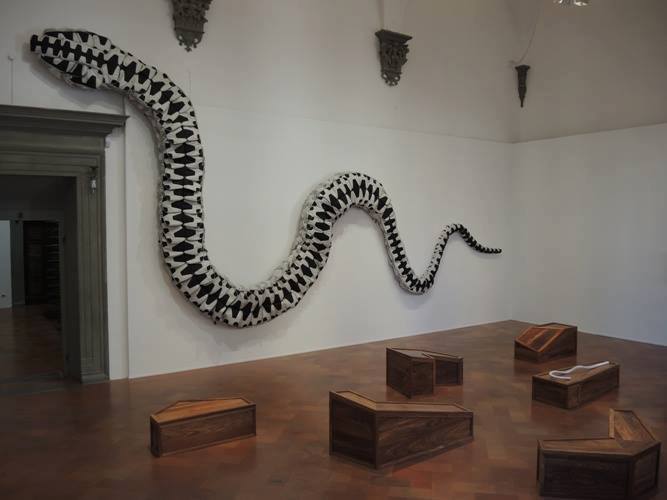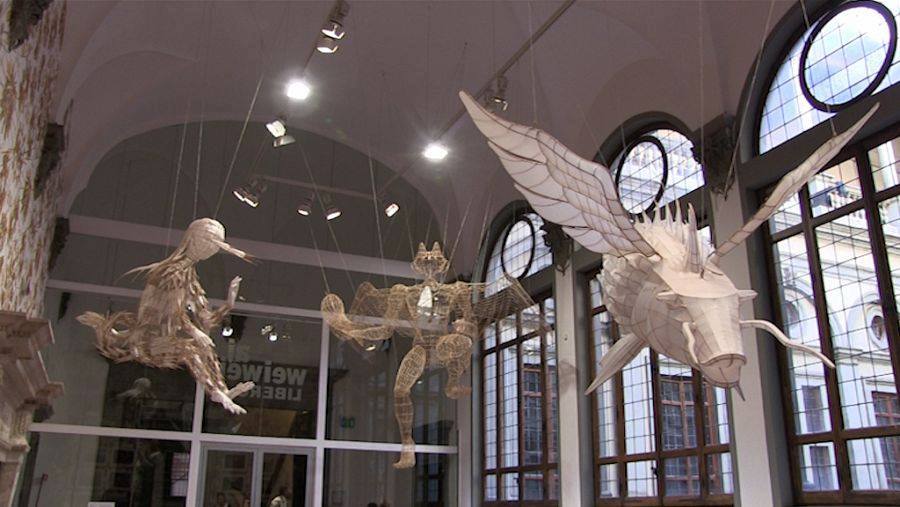Palazzo Strozzi
Dal 23 settembre 2016 al 22 gennaio 2017
Di Caterina Zaru (Università degli Studi di Firenze)
La mostra offre la possibilità di conoscere una “star” dell’arte contemporanea: l’artista cinese Ai Weiwei. Vorremmo, qui presentarvela da un punto di vista, non strettamente museologico-museografico, bensì della didattica.
L’artista affronta temi importanti, su tutti, la libertà di espressione. Lo fa riprendendo tecniche tradizionali cinesi, creando opere ex novo, realizzate da abili artigiani, o utilizzando oggetti già esistenti ma dando loro nuova vita (sulla scia dei ready-made di Duchamp).
Come si fa a raccontare tutto questo a bambini o ragazzi che non hanno nozioni né di storia, tanto meno di politica, né di arte contemporanea? In che modo si potrebbe spiegare che un’opera d’arte può raccontare una storia, suscitare emozioni e provocare sensazioni senza utilizzare le parole, ma attraverso i colori, le forme e lo stile dell’artista? Ad esempio, i gommoni dell’installazione Reframe (Nuova Cornice), grazie al colore arancione attirano la nostra attenzione, ma ad uno sguardo più attento, ci accorgiamo che essi esaltano la forma delle finestre del piano nobile, ricalcandone le sagome, per dirci come le cose antiche sono connesse a quelle moderne. Le biciclette dell’installazione nella prima sala del percorso interno, Stacked (Impilate), ci obbligano a passarvi all’interno, dando la sensazione di non aver altra scelta, come negli anni ’50 i giovani cinesi non avevano altra scelta che acquistare una bicicletta per affermare il proprio status sociale, addirittura per sposarsi.
Andando avanti, troviamo opere difficili da spiegare, perché trattano temi molto delicati o irriverenti. La sala dedicata al terremoto del Sichuan raccoglie le opere nate dall’indagine condotta da Ai Weiwei per ridare un nome a quei bambini che nel terremoto hanno perso la vita e che il governo cinese ha dimenticato. I giovani spettatori della mostra riconosceranno immediatamente gli zainetti che formano il grande serpente appeso alla parete, cioè l’opera Snake Bag (Borsa serpente). Lo zaino è per loro un oggetto di uso quotidiano, come lo era per quei bambini. Con la sola differenza che gli zaini dei bambini occidentali sono tutti diversi tra loro, mentre quelli mostrati da Ai Weiwei sono tutti uguali. Questo perché se egli non avesse portato a termine la propria indagine, non sarebbe stato mai possibile ridare loro la dignità di persone che sono state. Nell’oblio sarebbero stati tutti uguali, come gli zainetti.
La serie di fotografie Study of Perspective (Studio Prospettico) pone un altro problema, se il pubblico è quello dei bambini, perché il gesto che ricorre in ogni immagine è, per come è stato loro insegnato, diseducativo. Dietro ad ogni dito è immortalato un luogo o un monumento storicamente o culturalmente rilevante. I quali Ai Weiwei manda a quel paese, perché simbolo di una società e di una cultura che egli contesta. Forse allora ai bambini e ai ragazzi bisognerebbe far capire che l’opera d’arte può essere lo spunto per una riflessione più ampia e profonda, cioè che le immagini richiamano alla nostra mente altri concetti e non solo ciò che rappresentano.
I grandi animali di bambù della sala intitolata Mythologies, infatti, offrono molteplici opportunità per sviluppare l’osservazione, l’ascolto di una narrazione meravigliosa e la rielaborazione attraverso il gioco e la fantasia. Queste strane creature sembrano uscite proprio da uno dei tanti libri della tradizione cinese che raccontano di paesi lontani e luoghi misteriosi, popolati da esseri meravigliosi e straordinari. Raccontare una di quelle storie di fronte a queste opere, dimostrerebbe, una volta di più, ai nostri piccoli spettatori, quante cose meravigliose l’arte può evocare attraverso le immagini, le loro forme e i loro colori.
Translation by Rachyl Grussing
This exhibition offers the opportunity to know a ‘star’ of contemporary art: the Chinese artist Ai Weiwei. We would like to present here a point of view not necessarily museological but didactic.
The artist handles important topics, above all, the freedom of expression. He does this by using traditional Chinese techniques, creating new works, or by using existing objects but giving them new life (in the wake of Duchamp’s ready-made).
How do you explain all this to teenagers or children who have no knowledge of history, let alone politics or contemporary art? How can you explain that a work of art can tell a story, evoke emotions and provoke feelings without using words, through the colors, shapes, and style of the artist? For example, the rafts of the installation Reframe (Nuovo Cornice), thanks to the orange color, attracts our attention, but upon closer inspection we realize that they enhance the shape of the windows on the main floor by tracing their outlines, to tell us how old things are connected to the modern ones. The bicycle installation in the first room of the beginning of the exhibition path, Stacked (Impilate), forces one to pass through it, giving the feeling of having no choice, as those young Chinese in the 1950s were forced to buy a bicycle, or even to get married, to affirm their social status.
Moving forward, we find the works difficult to explain, because the subjects are very delicate or irreverent. The room dedicated to the Sichuan earthquake collects the works born from the survey that Ai Weiwei conducted to give name to the children who lost their lives, children the Chinese government has forgotten. The young audience of the show immediately recognizes the backpacks that form the grand serpent that hangs along the wall, the work Snake Bag (Borsa Serpente). For them, the backpack is an object of everyday use, as it was for those children in the earthquake. With the only difference being the Western children’s backpacks are all different from one another, while those shown by Ai Weiwei are identical. This is because if Ai Weiwei had not completed his investigation, it would not have been possible to give any dignity to those who were lost. Oblivion would be all the same, like the backpacks.
The series of photographs, Study of Perspective (Studio Prospettico), poses another problem if the audience is children, as the gesture that occurs in every image is one, as has been taught, morally destructive. Behind every image is immortalized a historical monument or culturally significant place. Which Ai Weiwei sends to the countries, since they are a symbol of society and culture that he criticizes. Perhaps then we should make clear to the children and young people that works of art can be the basis for a broader and deeper reflection, that is, that the images bring to mind other concepts and not just what they physically represent.
In fact, large bamboo animals, in the room entitled Mythologies offer multiple opportunities to develop observation, listening to wonderful storytelling and reprocessing through play and imagination. These strange creatures appear to be works from one of the many books in the Chinese tradition that tell of distant lands and mysterious places, populated by wonderful and extraordinary things. To tell one of these stories in front of these works demonstrates, once again, to our young viewers, how many wonderful things that art can evoke through the imagination, their form and their colors.

